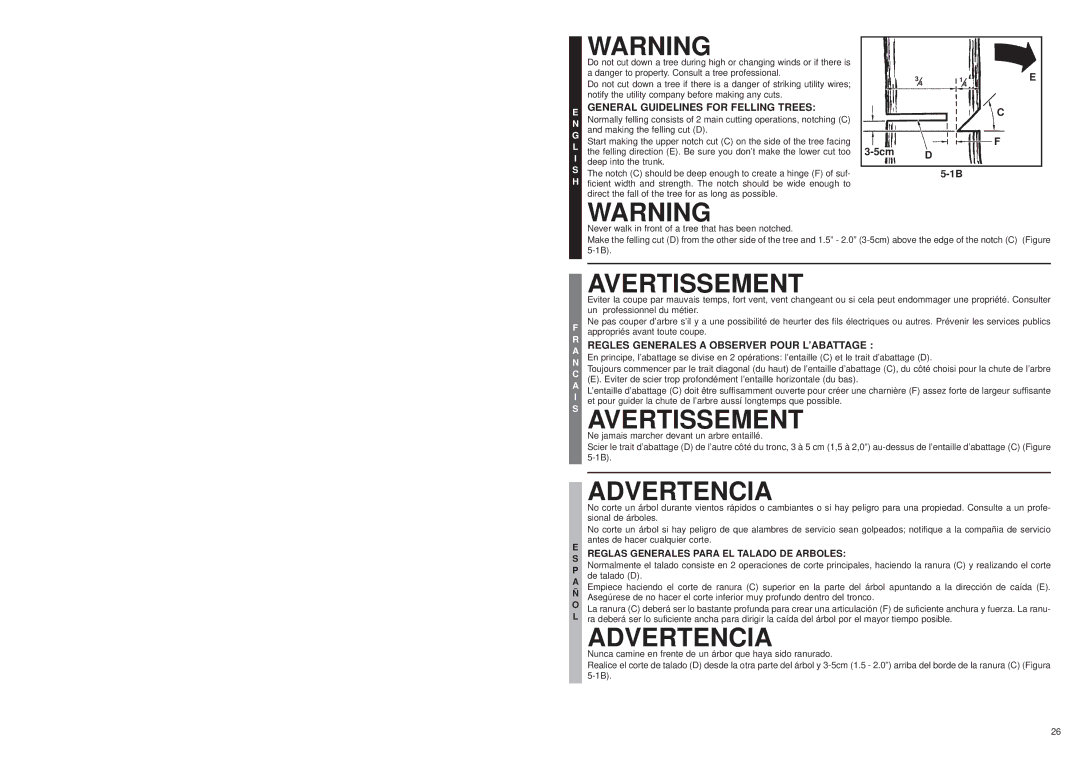
| Do not cut down a tree if there is a danger of striking utility wires; |
|
| 3⁄4 | 1⁄4 | E |
| notify the utility company before making any cuts. |
|
|
|
|
|
E | GENERAL GUIDELINES FOR FELLING TREES: |
|
|
|
| C |
N | Normally felling consists of 2 main cutting operations, notching (C) |
|
|
|
|
|
G | and making the felling cut (D). |
|
|
|
|
|
Start making the upper notch cut (C) on the side of the tree facing |
|
|
|
| F | |
L | the felling direction (E). Be sure you don’t make the lower cut too |
|
|
|
|
|
|
| D |
| |||
I | deep into the trunk. |
|
|
|
| |
|
|
|
| |||
S | The notch (C) should be deep enough to create a hinge (F) of suf- |
|
|
|
| |
H | ficient width and strength. The notch should be wide enough to |
|
|
|
|
|
direct the fall of the tree for as long as possible.
WARNING
Never walk in front of a tree that has been notched.
|
| AVERTISSEMENT |
|
| Eviter la coupe par mauvais temps, fort vent, vent changeant ou si cela peut endommager une propriété. Consulter |
|
| un professionnel du métier. |
F |
| Ne pas couper d’arbre s’il y a une possibilité de heurter des fils électriques ou autres. Prévenir les services publics |
| appropriés avant toute coupe. | |
AR |
| REGLES GENERALES A OBSERVER POUR L’ABATTAGE : |
N |
| En principe, l’abattage se divise en 2 opérations: l’entaille (C) et le trait d’abattage (D). |
C |
| Toujours commencer par le trait diagonal (du haut) de l’entaille d’abattage (C), du côté choisi pour la chute de l’arbre |
A |
| (E). Eviter de scier trop profondément l’entaille horizontale (du bas). |
| L’entaille d’abattage (C) doit être suffisamment ouverte pour créer une charnière (F) assez forte de largeur suffisante | |
I |
| et pour guider la chute de l’arbre aussí longtemps que possible. |
S |
| |
| AVERTISSEMENT | |
|
| Ne jamais marcher devant un arbre entaillé. |
|
| Scier le trait d’abattage (D) de l’autre côté du tronc, 3 à 5 cm (1,5 à 2,0”) |
|
| |
|
|
|
|
| ADVERTENCIA |
|
| No corte un árbol durante vientos rápidos o cambiantes o si hay peligro para una propiedad. Consulte a un profe- |
|
| sional de árboles. |
|
| No corte un árbol si hay peligro de que alambres de servicio sean golpeados; notifique a la compañia de servicio |
SE |
| antes de hacer cualquier corte. |
| REGLAS GENERALES PARA EL TALADO DE ARBOLES: | |
P |
| Normalmente el talado consiste en 2 operaciones de corte principales, haciendo la ranura (C) y realizando el corte |
A |
| de talado (D). |
| Empiece haciendo el corte de ranura (C) superior en la parte del árbol apuntando a la dirección de caída (E). | |
Ñ |
| Asegúrese de no hacer el corte inferior muy profundo dentro del tronco. |
OLa ranura (C) deberá ser lo bastante profunda para crear una articulación (F) de suficiente anchura y fuerza. La ranu-
Lra deberá ser lo suficiente ancha para dirigir la caída del árbol por el mayor tiempo posible.
26
